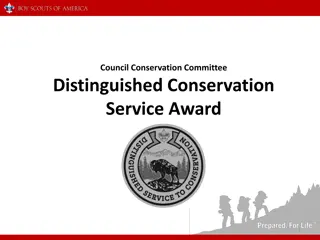Conservation Easements and Monitoring in Orange County by The Nature Conservancy
The Nature Conservancy plays a vital role in monitoring and managing conservation easement lands in Orange County, ensuring the protection of conservation values and natural resources. Through the Irvine Ranch Conservation Easements, they uphold specific permitted and prohibited activities while tailoring plans to each property, emphasizing the importance of maintaining ecological and human values. Easement holders bear the responsibility of ensuring compliance with the terms of the easements, reflecting the critical role of stewardship in conservation efforts.
Uploaded on Sep 06, 2024 | 0 Views
Download Presentation

Please find below an Image/Link to download the presentation.
The content on the website is provided AS IS for your information and personal use only. It may not be sold, licensed, or shared on other websites without obtaining consent from the author. Download presentation by click this link. If you encounter any issues during the download, it is possible that the publisher has removed the file from their server.
E N D
Presentation Transcript
Monitoring Conservation Easement Lands in Orange County The Nature Conservancy Zachary Principe
TNCs Orange County History 1990: Irvine Company s open space lands 1992: TNC assumes management of the 22,000 acres Docent program established in coordination with Laguna Greenbelt Natural resource management and monitoring programs initiated invasive species, wildlife and restoration 1996: NROC established. Assisted with development of monitoring and management programs 2002: The Irvine Company dedicates Conservation Easements on an additional 11,500 acres 2007: TNC s management role on Irvine Ranch transferred to Irvine Ranch Conservancy 2007 to present: Monitoring condition and enforce protection of Conservation Values on easement lands TNC prepares management plan for 22,000 acres of The
Conservation Easements Property has bundle of rights Land - ground surface Water, mineral, hunting Agricultural rights Grazing, orchards, vineyards . Development & subdivision rights Fee owner land itself & other rights Easement holder development rights Custom, perpetual legal instrument Fee with partial rights All rights Easement w/ partial rights
Irvine Ranch Conservation Easements Same basic structure, tailored to each property Conservation Values two types Vegetation communities and species (natural/ecological) Educational and recreational (human) Permitted Activities Prohibited Activities Resource Plans Mutually developed Determine the nature, extent and location of the specified uses
Irvine Ranch Conservation Easements Permitted Uses by land owner Infrastructure maintain, repair and replace what was present when easements were recorded New improvements on ~1% of lands Development of system of trails for passive recreation Prohibited Uses Any destruction of the Conservation Values No improvements buildings, signs, water tanks, roads No off-road vehicle use No dumping or salvage No destruction of native vegetation No agriculture
Easement Holder Obligations Easement holder s responsibility to ensure terms of easement are met No law enforcement or agency monitoring of easement compliance Reputation and non-profit status of easement holder at stake if not enforced Tax benefits income and property Easement Compliance Monitoring
Irvine Ranch Conservation Easements North Irvine Ranch Open Space 5 Easements Fremont Anaheim (Gypsum) Silmod (Silverado & Baker Canyons, Irvine Mesa) East Orange (Loma Ridge, Shoestring Canyon) Laguna Laurel (Parcel 5)
Conservation Values Community or Group Specific Conservation Values Coastal sage scrub, chaparral, grasslands, oak woodlands, rock outcrops, Tecate cypress forest, riparian forest, aquatic communities Vegetation Communities (8) Chaparral beargrass, many-stemmed dudleya, Catalina mariposa lily, Humboldt lily, Tecate cypress, big-cone spruce, heart-leaved pitcher sage Plants (7) Large Mammals (4) Mule deer, mountain lion, bobcat, coyote Bats (3) Mexican free-tailed bat, California mastiff bat, pallid bat Reptiles (2) San Diego mountain kingsnake, speckled rattlesnake Birds (3) Bell's sage sparrow, California gnatcatcher, black-chinned sparrow Invertebrates (1) San Diego fairy shrimp
Irvine Ranch Conservation Easements Goal: Preserve and protect in perpetuity the Conservation Values of the Property Two types of Monitoring Compliance Ecological
Preliminary Monitoring Goals Assess effectiveness of easements in protecting Conservation Values Status and trends of CVs and their threats Foster research and monitoring collaborations Develop efficient and effective monitoring programs Understand interactions between natural and human-use Conservation Values Understand external factors influencing CVs invasive species, fire, climate change, edge effects, air quality Assess the role of the easement lands in supporting large scale ecological processes and wide-ranging species within network of OC open space lands
TNC Monitoring of Conservation Values Bat monitoring Vegetation community monitoring Oak woodland monitoring Reptile and Amphibian monitoring Bird monitoring Lichen inventory Mountain lion activity monitoring Irvine Mesa baseline biological report
Bat monitoring Conservation Value Orange County supports a majority of bats in the South Coast Ecoregion More than half the species are listed as rare Most of the bats in OC are known to occur on easement lands Bats susceptible to human land uses
Bat monitoring goals 1. Species composition (including seasonal variations); 2. Roosting (locations, types, timing, species, numbers); 3. Foraging locations (seasonal use, hot spots); 4. Long-term patterns in species composition, diversity, and roosting; 5. Used to inform conservation activities
Lichen inventory Important biological component of rock outcrops Bioindicators Air quality Climate change Inventory to establish baseline on diversity and composition of the lichen community Investigate influence of fire and track recovery Proposed survey of established plots/sites every 5 yrs
Vegetation Monitoring Conservation Values Grasslands Chaparral Coastal Sage Scrub Design a monitoring program that is effective, efficient, transparent and defensible. Describe status and trends of species richness and cover
Oak Woodland Monitoring Objectives Develop a robust and cost effective monitoring protocol Provide information on oak populations relevant for measuring oak woodland viability and easement success Goals Describe the current status of adult oaks in woodlands Understand if oak woodlands are likely to persist in the future Evaluate different methods to estimate woodland structure and tree condition Evaluate the power and robustness of the monitoring program
Bird Monitoring Objective: Obtain baseline bird community composition data Goals: Characterize bird species richness and abundance Document populations and locations of special status bird species Refine the habitat associations of individual species Monitor the natural recolonization of bird species into burn areas Use baseline data to develop monitoring program to detect trends in species richness and abundance
Looking Forward Track changes to status of Conservation Values Maximize effectiveness and efficiency Collaborate with partners Monitoring at the appropriate scale to obtain meaningful for result for communities and taxa Utilize baseline data to guide establishment of long-term monitoring program























